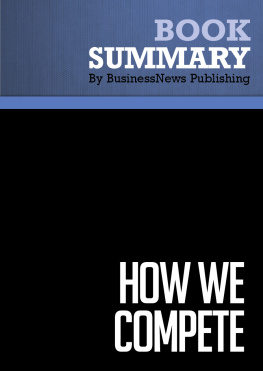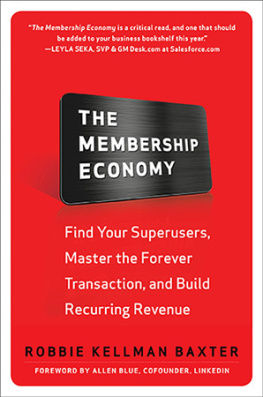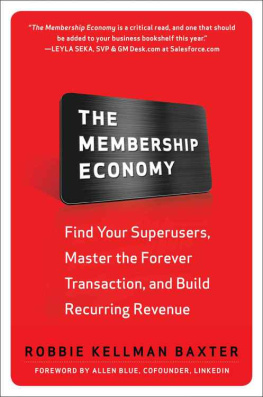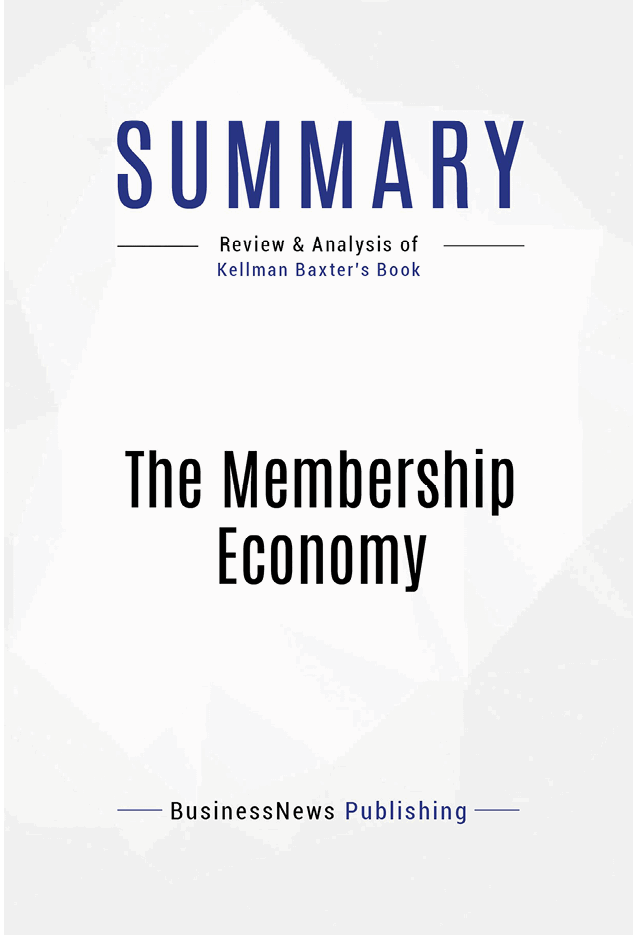Book Presentation: The Membership Economy by Robbie Kellman Baxter
Book Abstract
MAIN IDEA
Many of the heavy hitters of the corporate world like Apple, Amazon and just about every big start-up around are busy at present changing their business models from selling individual products to offering memberships which generate ongoing recurring revenues. This is indicative of the rise in the membership economy which looks set to become much larger in the future.
So what is the "Membership Economy"? Pure and simple membership means customers engage with an organization or a group on an ongoing basis. It's where an organization puts the customer relationship at the center of the business model rather than the product, the customer experience or even making a one-time sales transaction.
Today, the rise of social media and other technology makes it easier than ever for customers to have an ongoing relationship with your organization. If you can get them contributing to the experience of other customers in positive ways, you'll have a powerful competitive edge over companies which merely act as product or service vendors.
"I'm convinced that the Membership Economy will have as profound an effect on society as the Industrial Revolution or the spread of the automobile. Today, the promise of membership is greater than ever. Evolving technologies have dramatically enhanced the ability of a broad range of industries to take advantage of membership models. The relationship between customer and organization is ongoing and formal, a 'forever transaction' that has implications across the organization, changing everything."
Robbie Baxter
About the Author
ROBBIE KELLMAN BAXTER is the founder of Peninsula Strategies, LLC, a strategic marketing consulting firm. She has consulted with clients in 20 industries including Netflix, SurveyMonkey and Yahoo! Before starting Peninsula Strategies, Ms. Baxter was a consultant at Booz Allen & Hamilton and a Silicon Valley product marketer. She is also an accomplished public speaker and has had articles published in the Wall Street Journal, The New York Times and Consumer Reports. She is a graduate of Harvard College and the Stanford Graduate School of Business.
The Web site for this book is at www.membershipeconomy.com .
Important Note About This Ebook
This is a summary and not a critique or a review of the book. It does not offer judgment or opinion on the content of the book. This summary may not be organized chapter-wise but is an overview of the main ideas, view points and arguments from the book as a whole. This means that the organization of this summary is not a representation of the book.
Summary of The Membership Economy (Robbie Kellman Baxter)
1. What exactly is the Membership Economy?
Membership means organizations build their businesses around generating recurring revenues by connecting with their customers on a long-term basis. It means winning the hearts and voices of customers rather than viewing every purchase as a one-time event.
Memberships are not new. They have always been around in one form or another. What is different is that consumers are now starting to show their willingness to pay a premium if they can connect with a community of like-minded individuals who can help them get more done.
This preference for connection with others is being driven by several transformative business trends:
- The general ubiquity of online access via multiple devices, especially mobile phones.
- The dramatic decline in the cost of data storage and processing which enables companies to provide access at very low prices.
- The decline of face-to-face communities and their replacement with virtual alternatives.
- The availability of news providers, photo sharing sites, video sharing services and more.
The membership economy is growing rapidly because even in the face of technological advancement, humans have a deep and abiding need to connect with others who share our values. The membership economy is energized by helping people form genuine connections to meet those needs.
Most membership businesses leverage some kind of subscription payment. The size of that payment varies widely. The funds generated are then used to pay for the infrastructure and to fund the acquisition of additional material and content. If there is no ongoing subscription payment, then the business model is more part of the sharing economy than the membership economy. Sharing is big as well but it's really just a subset of the overall membership economy.
Traditionally, much of the economy has operated on the principle of ownership. Companies and consumers buy assets, own them and therefore are free to do what they like with them. Ownership is good but it always comes with its own set of responsibilities and costs. Membership suggests that rather than owning something you will only use occasionally, you're better off renting access as and when you need it.
Ownership and membership are at opposite ends of the spectrum:

The pendulum right across the economy is swinging from ownership to membership at the present time. People are becoming frustrated by the burdens of having too much stress and are increasingly looking for meaningful connections and a sense of community. Membership-based businesses provide that.
The membership economy's growth in dozens of different industries in recent times has been driven by three major advantages:
- The membership business model creates recurring revenue which is often described as the "Holy Grail" of business. Membership also removes the lumpiness in revenue streams which arises due to seasonality.
- Membership builds a direct relationship which ultimately strengthens the brand. By putting customers at the center there is more loyalty and less likelihood competitive threats will arise.
- Membership creates an ongoing data stream which companies can use to improve products and services and identify opportunities to increase customer satisfaction. Membership organizations are learning organizations and it shows.
While membership organizations can come in a wide variety of flavors or formats, there are really just six basic types which get used most frequently:
- Digital subscriptions where members pay a recurring fee for access to content, features, services, etc. May use the "freemium" model where some members pay nothing and others pay for premium add-ons. Examples: Netflix, Dropbox, etc.
- Online communities members pay to interact with like-minded peers. LinkedIn, Facebook, etc.
- Loyalty programs where members get rewards for their ongoing commitment and business. Starbucks, Caesars Entertainment, frequent flier programs, etc.
- Traditional membership organizations like those offered by American Express to its cardholders or Weight Watchers.
- Small businesses and consultancies which can offer memberships for ongoing services. Examples: Million Dollar Consultant Alan Weiss and Kepler's Books.
- Non-profits, professional societies and trade associations which typically reinvest surplus revenues into projects rather than distributing them as dividends to owners. Examples: Sierra Club, AARP, the Association of Professional Photo Organizers, etc.








